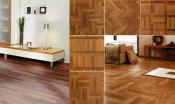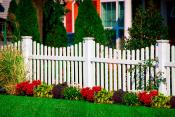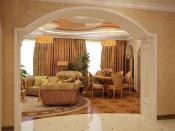Search
Login
How to install the gate on your own from the corrugated board
Owners of country houses with special responsibility approach the choice of gates, because this element of the garden has a functional and decorative role. The gate should reliably protect the property from uninvited guests, and be an integral part of the design of the suburban area.
The most popular material for the manufacture of wickets is a profiled sheet. The finished product has all the necessary qualities and goes well with different types of fences, in particular, with a fence from corrugated board.
Content
- What material to use in the manufacture of gates for the fence of corrugated board video
- Wicket drawing: choosing the optimal shape and size
- Making and installing a do-it-yourself wicket
- Wicket decoration options
What material to use in the manufacture of gates for the fence of corrugated board
A gate is a single-leaf door that can be located in a gate or fence. It serves as a kind of business card for a personal plot, so the material for manufacturing the gate should be not only durable, but also aesthetically attractive.

Usually, the appearance and type of the wicket door is selected according to the fence or the already installed gate. However, there are exceptions. In the fence of corrugated board, you can install a gate of the following materials:
- metal sheet;

- a metal bar or grid (if the gate does not go outside, but into the garden or vegetable garden);

- forged welded rods;
- polycarbonate with a metal frame.
With all the abundance of building materials, the best option for a fence from corrugated board remains a gate made of the same material.

Profile sheet as a material for fencing, has many significant advantages:
- Convenience and speed of installation. A metal plate structure can be erected in 1-2 days, and all work can be done independently.
- Good performance.Profile sheets are coated with an anticorrosive, polymer layer and varnish, which enhances the product's resistance to various weather conditions.

- Duration of operation. The service life of a wicket from corrugated board is 50 years or more.
- Attractive appearance. Wavy metal plates are made in different shades and colors. There is an opportunity to choose the best option, perfectly complementing the exterior of buildings and landscaping of the garden.

When choosing a material for the manufacture of gates in the fence from a professional sheet, you should pay attention to such parameters:
- The shape and height of the wave. The rigidity of the future design and the field of application of the material depend on the wave. The marking of the profiled sheet has the following decoding:
- N - bearing, used during roofing (has high strength and high cost);
- C - wall, intended for the arrangement of fences (walls, partitions, fences);
- CH - material is applicable for the construction of fences and roofs.

- Type of coverage. For the manufacture of gates, it is not recommended to use a sheet coated with zinc only; a slight surface scratch will make the metal exposed to corrosion. It is better to give preference to a core sheet with a polymer (plastisol or polyester) coating. Such material is more resistant to mechanical stress.
The optimal corrugated board for the wicket (in the price / quality ratio) is marked C10, C20, C21, HC35. Digital designation corrugation height in mm
Wicket drawing: choosing the optimal shape and size
Before you make a gate in the fence, you need to determine the dimensions and shape of the structure. A competent calculation will help to avoid problems during operation: inconvenience of use due to a wide or too narrow wicket door, premature wear of the lock or hinges of the structure.

The optimal dimensions for the door are the following indicators:
- the width of the gate in the fence is about 1 meter;
- door height no more than 2 meters.
If the fence is higher than 2 meters, then on the gate you can make the upper insert with a crossbar, this will reduce the load on the support column and visually preserve the integrity of the structure
Most owners of household plots prefer to install a wicket for the fence from corrugated board of a simple shape: square or rectangular. However, some craftsmen make more original designs in the form of arches.

Creating a figured door is a more complex technological process, requiring certain knowledge of geometry and drawing. When calculating and manufacturing such a gate, it must be taken into account that gaps may appear from the top of the door through which the fenced area of \u200b\u200bthe site will be visible.
After creating a drawing of the future gate, it is necessary to calculate the consumption of material and proceed to the manufacture of the fence.
Making and installing a do-it-yourself wicket
Preparation of tools and materials
Of the materials for creating a gate you will need:
- corrugated sheet of the desired size;
- a pipe for the manufacture of support columns with a cross section of 60 * 60 to 80 * 80 mm;

- pipe for the frame with a section of 40 * 20 or 40 * 40 mm;
- a pipe for creating stiffeners with a square section of 20-25 mm;
- crushed stone;
- sand;
- cement;
- paint for supports and frame;
- primer for metal;
- small pieces of roofing material;
- bituminous mastic.
The wicket frame from a pipe 40 * 40 mm in size will be more rigid, and it will be easier to mount a narrow-profile lock in it
To implement the project, you need to prepare the following tools:
- welding machine (optimally inverter welder, designed for a current of 160-200 Am);

- grinder for pipe cutting;
- metal scissors for cutting a profile sheet;
- metal scriber;
- a screwdriver for attaching the profiled sheet to the pipe;
- garden drill (diameter 20-30 cm) for digging a hole under the support posts;
- concrete mixer or drill with mixer nozzle;
- scrap (needed when tamping gravel);
- tape measure, square, ruler.
The construction of support pillars
The ease of opening the wicket door depends on how accurately and evenly the support posts are installed.
Supporting posts can be:
- metal pipes;
- stone or brick pillars.
Consider the option of how to install a gate using metal pipes as supports.
- Mark the location of the pits along the fence line.
- Dig a hole with a shovel or with the help of a garden drill (the depth of the hole is 1.2 meters).
- Grinder to cut a metal pipe:
- pipe length \u003d height of the gate (according to the drawing) + part to be dug into the ground;
- optimal table depth 1 meter.
- To clean pipes from scale and rust, and then to cover with a primer. Leave to dry completely.
- Line the bottom of the pit with roofing material and cover with rubble.
- Coat the lower edges of the support pipe with bitumen mastic and install them in the pit strictly according to the plumb line and level.

- Tamp the rubble with a crowbar.
- Fill the pits with concrete mortar (cement to sand ratio 1: 3).
It takes about three to four weeks for concrete to solidify completely. But, since the weight of the gate is not large, it will be possible to continue installation work in a week.

When erecting pillars of stone or brick, the entire lining is laid out around the metal pipe. To the pipe, you need to weld the embedded plates in advance and remove them on top of the brick for fastening the loops.
Gate frame: manufacturing and installation
On a profile pipe with a section of 40 * 40 or 40 * 20, it is necessary to outline the dimensions of the workpieces (horizontal and vertical sides of the frame) and cut them off with a grinder at an angle of 45 degrees. An angled cut will improve the quality of the weld.

When using a pipe with a cross section of 40 * 20 mm, the wide side should be fixed perpendicular to the plane of the fence
The cut frame elements must be well cleaned, degreased with a solvent and treated with an anti-corrosion compound. Lay the pipes on a flat surface and grab the frame in all corners.
The evenness of the design can be checked by comparing the diagonals of the frame, they should be equal. If necessary, the frame must be aligned and adjusted to the drawing. After that, you can finally boil the corners.
To give the frame stiffness and strength, you can weld a horizontal jumper (pipe with a cross section of 20-25 mm). The jumper is not necessary to place in the middle of the gate, it can be located slightly above or below the center of the door.

The last stage of creating the frame is welding the canopies along the vertical axis.
Frame installation is carried out in compliance with the following rules:
- The distance from the supports to the frame on both sides should be no more than 1 cm. This gap is necessary for easy opening / closing of the gate.

- The distance between the door leaf and the sidewalk or track lining should be at least 10 cm. Such a working gap is necessary for the normal operation of the gate in the winter when ice accumulates.
The frame is set to the desired height, and the awnings are welded to the post. If the gate opens and closes effortlessly, then the awnings are welded correctly and the frame is not skewed.
Installation of the lock and profiled sheet
The place for installing the lock must be provided in advance when welding the frame:
- The lock must be attached to the profile pipe and mark the location of the keyhole on the profiled sheet and the contours of the holes in the support.
- To grill a hole with a small circle.
- The edges of the holes are filed and tinted.
- The final installation of the lock is made after sheathing the gate with a profile sheet.

A sheet of metal profile necessary in size is cut off and fastened with 35 mm screws to the corners of the frame. Fasten the corrugated board around the perimeter of the gate (each wave can be fixed or through one) and along the transverse beam.

One square meter of corrugated board must be fastened with at least six self-tapping screws
Through the support pipe, you can run electrical wiring for mounting additional elements: intercom, buttons for a call or a lamp. At the end of the work, the support posts must be welded on top with steel covers so that water does not get into the profile.
Wicket decoration options
We considered the option of how to install a wicket from corrugated board, consisting of a metal frame and a profile sheet. This is the most common and budget way. There are also more complex technologies for creating gates using decorative and functional elements.
A wicket looks very elegant and elegant, in which the corrugated board acts as a background layer, and forged art grating is mounted in the foreground.

A wicket gate with forging requires the installation of reinforced supports, since the metal grille greatly complicates the structure
Forged elements can not be placed over the entire area of \u200b\u200bthe door, but only for finishing different parts of the gate, for example, to frame the top. This method visually lengthens the gate and is perfect for high fences.

The use of corrugated board imitating wood, masonry or brickwork helps to create a wicket that looks as advantageous as fences made of natural materials.

Technology does not stand still, and today, any pattern can be transferred to corrugated board. Of course, this will slightly increase the cost of the gate, but at the same time, it will highlight the infield among the rest.
It will improve the appearance and give the functionality of both the garden and the entrance gates a decorative peak and sealed lamps mounted on the support posts.

As you can see, the independent installation of the gate in the fence from corrugated board does not require special knowledge and building skills from the manufacturer, and if you approach the workflow creatively, you can create a unique business card for a personal plot.





